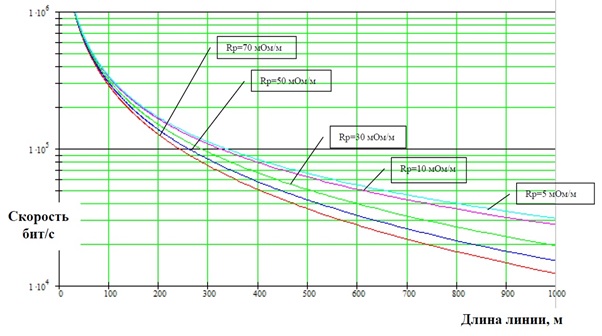Measuring lines: design process
of the structural health monitoring system (SHM)
The total length of measuring lines is a very important factor that is to be considered during measuring lines design.
Measuring lines length is determined as a total length of the cables used for connection of sensors to the measuring line (including the cable between interface converter and the first sensor of the measuring line). Total cable length determines the speed values that will be available at the interface.

From the diagram shown above one can see that for the speed value of 1 Mbps the total measuring line cable length should not exceed 40 meters, while for the speed value of 100 kb/s the total measuring line cable length is limited by cable type – for the cables with low resistance per unit length (5 mOhm/m) it is 340 meters, and for the cables with high resistance per unit length value (70 mOhm/m) it is 250 meters.
When selecting the cable type to be used for the measuring line one should take into consideration the following requirements:
- the cable should have two screened twisted pares (it is also possible to use four screened twisted pares);
- the cable should meet the requirements of the corresponding temperature range;
- in the case if standard power supply scheme for digital sensors is used (via one of the twisted pairs) the cable type should be selected in accordance with table specifying cable types recommended for various measuring line parameters.
| Requirements for the designed measuring line | Recommended type of measuring line cable | ||
| Length | Digital sensors total consumed power | Interface type and maximal speed of the interface | |
| up to 40 m | up to 12 W | CAN 1Mbps RS-485 115.2 kbps |
Cabeus RS-485 2x2x24AWG/7 Cable for interface RS-485/RS-422, 2x2x24 AWG, multicore, operational temperature range – 45 C – +80 C. Alternative: Belden 9842 (305м), Teldor 9392L02129D#30T |
| up to 20 W | CAN 1Mbps RS-485 115.2 kbps |
Cabeus RS-485 2x2x22AWG/7 К Cable for interface RS-485/422, 2x2x22 AWG (SF/UTP), multicore, operational temperature range -55°С – +70°С. Alternative: Belden 3107A (305м), Teldor 9FY9F2L101 |
|
| up to 100 m | up to 5 W | CAN 300 kbps RS-485 115.2 kbps |
Cabeus RS-485 2x2x24AWG/7 Cable for interface RS-485/RS-422, 2x2x24 AWG, multicore, operational temperature range – 45 C – +80 C. Alternative: Belden 9842 (305м), Teldor 9392L02129D#30T |
| up to 8 W | CAN 300 kbps RS-485 115.2 kbps |
Cabeus RS-485 2x2x22AWG/7 Cable for interface RS-485/422, 2x2x22 AWG (SF/UTP), multicore, operational temperature range -55°С – +70°С. Alternative: Belden 3107A (305м), Teldor 9FY9F2L101 |
|
| up to 250 m | up to 3,5 W | CAN 100 kbps RS-485 57.6 kbps |
Cabeus RS-485 2x2x22AWG/7 Cable for interface RS-485/422, 2x2x22 AWG (SF/UTP), multicore, operational temperature range -55°С – +70°С. Alternative: Belden 3107A (305м), Teldor 9FY9F2L101 |
| up to 20 W | CAN 100 kbps RS-485 57.6 kbps |
Toll cable for networks DeviceNet, 2×18 AWG + 2×15 AWG S/STP (IEC 60332-1), cable housing: fire-resistant LSZH compound (FR-LSZH) | |
| up to 500 m | up to 10 W | RS-485 19.2 kbps | Toll cable for networks DeviceNet, 2×18 AWG + 2×15 AWG S/STP (IEC 60332-1), cable housing: fire-resistant LSZH compound (FR-LSZH) |
| up to 800 m | up to 5 W | RS-485 19.2 kbps | Toll cable for networks DeviceNet, 2×18 AWG + 2×15 AWG S/STP (IEC 60332-1), cable housing: fire-resistant LSZH compound (FR-LSZH) |
